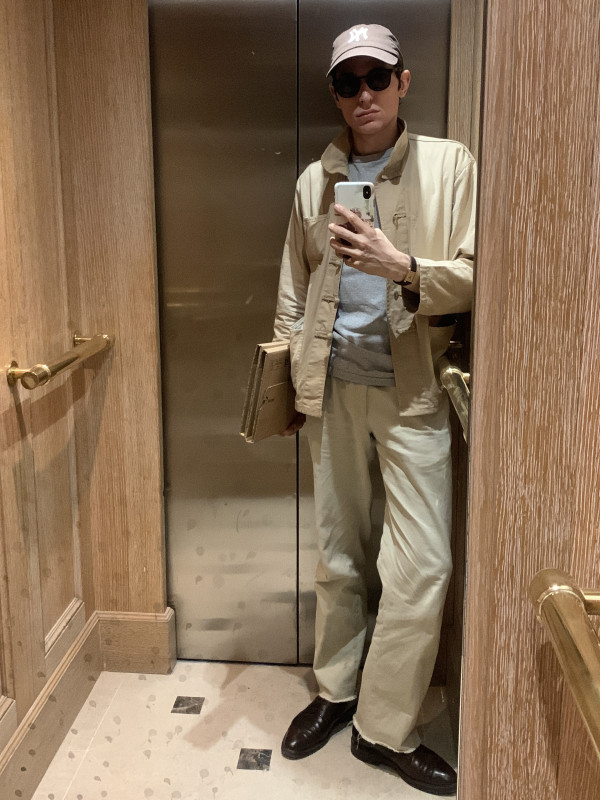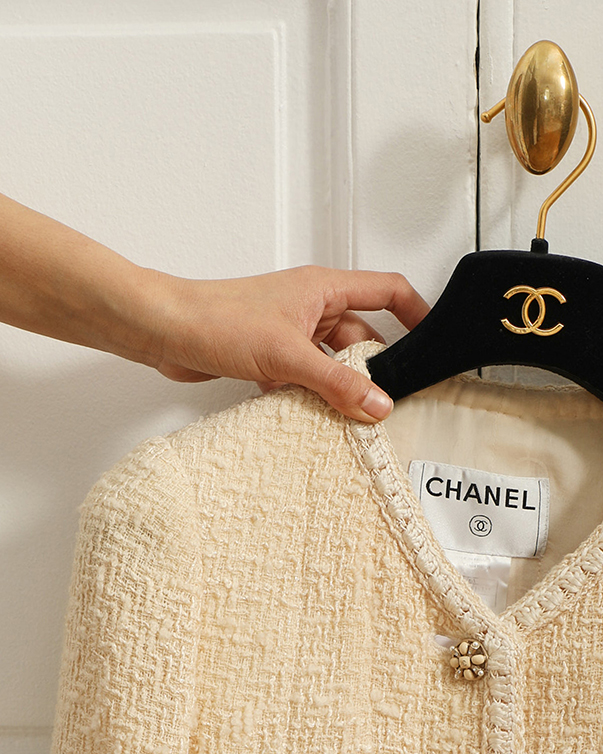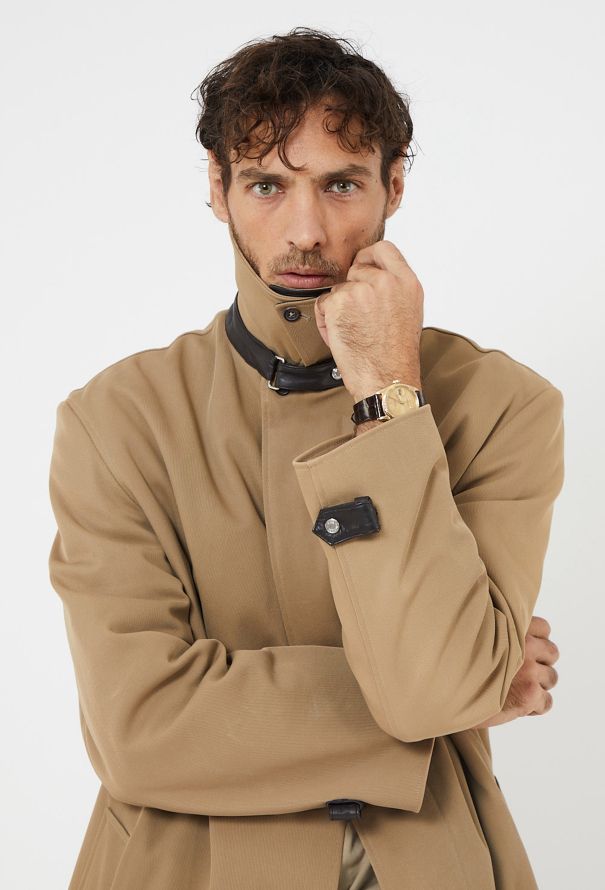Revue De Style : Christopher Niquet

Lorsque Christopher Niquet, qui avait accumulé une multitude de trésors — des vêtements sur mesure aux livres rares — au cours de ses 14 années passées à New York, est retourné dans son Paris natal en 2020, ses bagages étaient étonnamment légers. « Je préfère posséder très peu de pièces, mais soigneusement choisies », confie ce vétéran de l'industrie de la mode, qui applique désormais ce même œil exigeant aux pages de sa publication, Study. À l'approche de la sortie du huitième numéro du magazine, il évoque ci-dessous son uniforme vestimentaire, le frisson de la seconde main et les objets porteurs de sens.
Avez-vous toujours su que vous vouliez travailler dans la mode ?
Au lycée, Carine Roitfeld a pris la direction de French Glamour pendant six mois avant que le magazine ne cesse de paraître. Il présentait tous les photographes en vogue, comme David Sims et Juergen Teller. C'est à ce moment-là que j'ai commencé à m'intéresser aux images de mode et aux magazines. J'ai commencé à acheter The Face et i-D pour leur mélange de mode, de musique et de culture, puis les magazines français, notamment Self Service, qui venait de sortir. À l'époque, c'était avant les réseaux sociaux et les sites web, et les magazines étaient vraiment un carrefour pour des choses inédites. Je découvrais des visions très différentes de la représentation des femmes, du style masculin, des musiciens, des films... Mon éducation s'est faite à travers ces magazines.
Pendant mes études universitaires, j'ai envoyé des lettres à French Vogue, Self Service et Libération. J'ai obtenu un stage chez chacun d'eux, mais Self Service nécessitait le moins de temps, ce qui me permettait de continuer mes études. Le stage durait trois mois, et, à la fin, ils m'ont demandé si je voulais rester six mois de plus, puis encore six mois, et j'ai finalement arrêté l'université pour accepter un poste là-bas. C'est ce qui a consolidé mon amour pour la mode, mais c'était plus pour le magazine que pour les vêtements, car j'ai toujours été un habilleur assez ennuyeux. J'aidais tout le monde au magazine, en particulier Suzanne Koller. Ces magazines n'avaient pas beaucoup de texte, donc ce qui prenait beaucoup de temps, c'était la création de visuels. C'est ce qui m'a conditionné à commencer en tant que styliste.
Je suis resté avec eux pendant trois ans, mais, finalement, je voulais essayer quelque chose de différent et je suis parti sans avoir de plan de secours. Je m'intéressais à la direction artistique pour un label musical, et j'ai découvert qu'A.P.C. avait un label de musique qu'ils voulaient créer indépendamment de la maison de mode. L'idée me plaisait parce que je ne travaillerais pas dans la mode, mais c'était toujours un monde que je connaissais. J'ai postulé pour le poste et j'ai rencontré Jean Touitou. Il écoutait Cat Power, qui était une amie à moi, donc l'entretien s'est bien passé parce que je la connaissais ainsi que sa musique. Je pense que c'est la seule raison pour laquelle j'ai obtenu le poste, car je n'avais vraiment aucune expérience dans la musique. Très vite, Jean a commencé à me demander de jeter un œil aux collections d'A.P.C. également. C'est à ce moment-là que j'ai reçu des propositions pour faire du stylisme dans les premières pages de magazines britanniques indépendants, comme Another et Dazed.
Après deux ans chez A.P.C., le magazine français Mixte m'a demandé de devenir directeur de la mode. À mon arrivée, Mixte avait encore l'aura de Babeth Djian, qui a ensuite fondé Numéro, et d'Emmanuelle Alt, qui avait été rédactrice en chef avant de rejoindre Vogue. J'ai l'impression qu'ils voulaient simplement quelqu'un de peu coûteux et ont dit : « D'accord, essayons quelque chose. » Mais cela a très bien fonctionné, et nous sommes passés de quatre à six numéros par an. C'était la première fois que je n'étais pas dans un poste d'assistant ; j'ai appris à assembler quelque chose en travaillant là-bas et j'ai fait venir David Bailey, Ellen von Unwerth et David Armstrong. Deux ans plus tard, j'ai démissionné et j'ai déménagé à New York.
Comment décririez vous votre style ?
Je pense que je suis revenu à mon style d'adolescent, pas nécessairement dans les vêtements eux-mêmes, mais dans l'esprit. Beaucoup de gens disent : « Oh, ma mère était si chic en portant du Saint Laurent... » mais mes parents étaient très conservateurs, du genre français normal, bleu marine et bordeaux. La mode ne faisait pas partie de la conversation. Je faisais de l'équitation en grandissant, donc quand j'ai commencé dans la mode, je portais des Barbours, des chinos, des bottes et des polos. Après avoir un peu modelé pour Hedi [Slimane] et Raf [Simons], j'ai reçu beaucoup de vêtements gratuits et j'ai commencé à expérimenter un peu plus, ce qui a été une bonne leçon de style, mais maintenant je suis revenu à porter des vêtements très normaux et classiques.
À New York, beaucoup de mes vêtements étaient faits sur mesure, mais faire ses propres choses peut presque devenir trop compliqué ou trop réfléchi. Quand j'ai eu 40 ans, j'ai réalisé que tout ce que je possédais semblait un peu trop spécial et précieux, alors je me suis débarrassé de tous mes vêtements et j'ai juste gardé les choses basiques. J'ai fait desportants de vêtements et j’ai invité mes amies à venir prendre ce qu’elles voulaient, puis j’ai donné le reste à Housing Works. Quand je suis rentré à Paris, je n’avais presque plus de vêtements. Aujourd’hui, je résiste à l’envie d’acheter du neuf ; je veux simplement profiter des bons vêtements que j’ai et les porter jusqu’à ce qu’ils se désintègrent. Ma garde-robe est vraiment centrée sur des vêtements de qualité que je peux porter tous les jours.

Christopher's Niquet private archive
Quels sont les essentiels de votre garde-robe ?
Les pièces que je porte en boucle sont une chemise Charvet à rayures jaunes, des polos en laine Leorosa dans trois couleurs, des Dickies bleu marine, beige, kaki et marron de chez Dave’s à New York, une parka Loro Piana et, en hiver, deux manteaux exceptionnels de The Row. Et mon cabas L.L.Bean. En fait, j’en ai deux : un vert armée, que je porte d’octobre à avril, et un blanc à anses jaunes pour les beaux jours.
J’ai toujours porté des bottines zippées avec un petit talon, mais celles que l’on trouve en boutique pour hommes étaient soit trop « cubaines », soit trop « cha cha », alors je suis allé voir un bottier à New York et nous avons conçu une paire inspirée des bottes de Jim Morrison et Jimi Hendrix. Mais en revenant à Paris, j’ai arrêté de les porter et je ne mettais plus que des bottes Harlech de Crockett & Jones – comme Amanda Harlech. Elles sont à lacets, presque comme des Converse en cuir. Récemment, j’ai trouvé une paire de bottines Edward Green chez Leffot, dans un cuir bleu marine foncé, assez similaire. Pour la première fois cette année, j’ai aussi acheté une paire de mocassins Alden en daim marron. Je les ai portés tout l’été. Et oui, je fais une incursion dans les Crocs maintenant. Je les ai en vert armée, que je porte tout le temps, et en blanc cassé ; celles-là sont encore toutes propres dans mon placard, mais leur heure viendra.
Comment intégrez vous le vintage dans votre garde-robe et votre intérieur ?
Beaucoup des vêtements que j’ai aujourd’hui sont vintage, comme ma parka Loro Piana et mes chinos. Le marché de la seconde main offre aujourd’hui beaucoup de pièces de bonne qualité et peu chères, donc, si l’on connaît une marque et qu’on sait qu’un vêtement nous va bien, il n’y a pas besoin de l’acheter plein tarif — et on ne participe pas à la surconsommation et au gaspillage de l’industrie. Aller en boutique ne m’amuse plus, mais il y a quelque chose d’agréable dans l’expérience de chiner sur un site vintage ou dans une boutique de seconde main ; même si beaucoup sont très sélectionnées, on a toujours l’impression de découvrir quelque chose de spécial, d’unique.
Pour la maison, c’est un peu différent ; c’est plus une question de surprise. Peut-être qu’il y a un objet qu’on a raté à l’époque et qu’on retrouve par hasard, ou peut-être que notre goût a légèrement évolué et qu’on le voit sous un autre angle, ou encore qu’on l’a croisé à un moment où on ne pouvait pas se le permettre, mais il est resté dans un coin de notre tête et on le retrouve quand on est prêt à l’acheter. Je préfère posséder très peu de choses, mais qui sont vraiment réfléchies. Il ne s’agit pas d’un achat impulsif mais plutôt de retrouver quelque chose que j’ai croisé il y a des années et que je suis maintenant prêt à intégrer à mon quotidien.
Quelles sont vos plus belles trouvailles ?
Une paire de chinos Loro Piana avec un ourlet brut — ils étaient trop longs alors je les ai coupés — et une surchemise beige vintage en cachemire Brioni, ultra fine, presque comme une écharpe. Les deux pièces que je préfère dans la maison sont un petit tabouret en bois de Charlotte Perriand, le premier meuble que j’ai acheté en revenant à Paris, et un canapé modulaire en flanelle grise, que [mon compagnon] Julian [Taffel] a trouvé sur un site allemand de seconde main.
Qu’est-ce qui est sur votre wishlist ?
Côté vêtements, mon seul regret est d’avoir donné mes pièces Helmut Lang que j’avais achetées au début de la vingtaine, quand Century 21 proposait encore de vraies bonnes affaires. J’aimerais retrouver un beau costume Helmut Lang et une veste en jean de la fin des années 90. Je cherche régulièrement, mais c’est très difficile de trouver les pièces originales.
Vous avez consacré votre livre Models Matter aux mannequins en 2017, et votre prochain numéro de Study leur est aussi dédié en tant qu’icônes culturelles. Quels sont vos mannequins préférés ?
Une de mes mannequins préférées est Donna Mitchell, muse de Bob Richardson, devenue ensuite actrice ; [Steven] Meisel la photographie encore parfois. J’adore aussi Susan Forristal, aujourd’hui décoratrice d’intérieur. Elles sont toutes les deux new-yorkaises, des années 60/70, et ont poursuivi d’autres carrières. Elles ne correspondaient pas aux standards de beauté de l’époque, mais leur personnalité et leur style faisaient qu’elles étaient choisies. Bien sûr, il faut être belle et photogénique, mais ce qui m’intéresse, ce sont les mannequins qui comprennent vraiment le processus créatif et qui construisent un personnage pour lequel elles sont demandées. Elles arrivent avec un tout.
Vous aviez aussi une immense collection de livres vintage, dont vous avez revendu une partie. Comment avez-vous décidé lesquels garder ?
J’ai tendance à devenir obsessionnel avec certaines choses, et la quête devient alors très excitante. J’avais beaucoup de livres, mais lors de mon déménagement, je me suis demandé ce qui était vraiment essentiel pour moi, et j’ai réalisé que beaucoup de ceux que je possédais n’étaient pas ceux vers lesquels je revenais. Donc, quand je suis rentré à Paris, j’ai décidé de ne garder que ceux auxquels j’étais émotionnellement attaché, comme mes livres d’Avedon — parmi les premiers que j’ai achetés — et ceux de David Armstrong, avec qui j’avais une relation proche. Côté auteurs : Raymond Carver, Joan Didion, Tom Wolfe, Jean-Jacques Schuhl et Marguerite Duras, dont le style d’écriture m’inspire ou me rassure ; leur liberté me donne presque la légitimité d’écrire à ma façon, même avec des fautes. Se débarrasser des autres n’a pas été si difficile. J’ai une bonne mémoire photographique, donc je n’avais pas besoin de tous ces livres de photos. Et j’aime l’idée de pouvoir déménager rapidement, en deux semaines. C’est une belle sensation que d’être mobile et de ne garder que ce qui reflète son goût et son mode de vie.
Quels sont vos livres de mode préférés ?
Fashion, édité par Camilla Nickerson et Neville Wakefield à la fin des années 90, est un excellent livre, car il propose une étude de la photographie de mode à un moment charnière, lorsqu’on passe des photographes classiques à une nouvelle génération d’artistes. C’est l’un des rares livres que j’ai conservés, que je consulte souvent et auquel je me réfère. J’adore aussi A House is not a Home de Bruce Weber, Goodbye Baby & Amen de David Bailey, avec sa collection de portraits des années 60, et The Beginning, un nouveau livre de Tina Barney sur ses premières photographies de gens à New York et dans l’Idaho, dans les années 70.
Avez-vous des règles de style ?
J’en avais une grande que j’ai récemment abandonnée : ne jamais porter de noir. J’ai toujours considéré le noir comme une solution de facilité — et je ne voulais pas être encore un autre professionnel de la mode vêtu de noir, alors j’avais consciemment banni cette couleur. Mais, l’été dernier, j’ai trouvé un polo Lacoste à manches longues noir pour 5 $ dans une boutique des Hamptons, et j’ai réalisé que j’aimais bien le noir, en fait. Je n’ai rien racheté en noir depuis, mais je suis désormais ouvert à l’idée d’en porter.
Quelle est votre plus grande aversion en matière de style ?
Les gens qui changent totalement de style à chaque saison. À l’époque de Phoebe Philo chez Céline, beaucoup de personnes dans la mode avaient soudainement un look incroyable, car son style mettait les femmes en valeur. Mais dès qu’elle est partie, ces mêmes personnes portaient du Vetements de la tête aux pieds ou avaient déjà basculé vers une autre marque, un autre look. Je trouve ça toujours un peu triste. Pour moi, on peut retrouver le même type de pièce chez plein de créateurs différents. Évidemment, une garde-robe évolue avec les tendances et les envies d’expérimentation, mais quand on fait un virage à 180°, c’est qu’on n’a pas de style personnel. On peut bien s’habiller, mais à la manière d’un « fashion victim ».
Quelle est votre adresse secrète pour le style ?
Cela fait longtemps que je n’y suis pas allé, mais j’adore le tailleur Mr. Ned à New York. Beaucoup de mes costumes venaient de chez lui. Je les ai tous donnés car ils avaient une silhouette très années 70, que je n’avais plus envie de porter, mais je retournerai sûrement un jour là-bas pour un nouveau costume sur-mesure.
DÉCOUVREZ LA SÉLECTION DE CHRISTOPHER
Chez ReSee, chacune de nos pièces vintage ont une histoire. Cela en grande partie grâce à notre communauté imbattable de collectionneurs.
Vendez avec nous

















